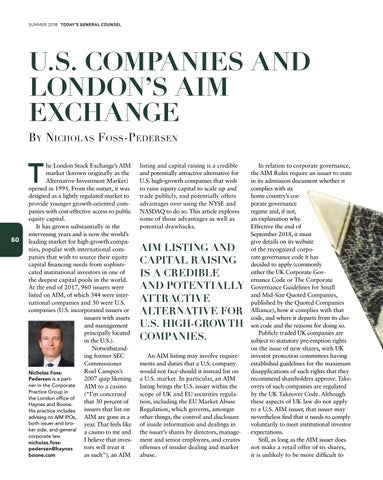SUMMER 2018 TODAY’S GENER AL COUNSEL
U.S. COMPANIES AND LONDON’S AIM EXCHANGE By Nicholas Foss-Pedersen
T
60
he London Stock Exchange’s AIM market (known originally as the Alternative Investment Market) opened in 1995. From the outset, it was designed as a lightly regulated market to provide younger growth-oriented companies with cost-effective access to public equity capital. It has grown substantially in the intervening years and is now the world’s leading market for high-growth companies, popular with international companies that wish to source their equity capital financing needs from sophisticated institutional investors in one of the deepest capital pools in the world. At the end of 2017, 960 issuers were listed on AIM, of which 344 were international companies and 50 were U.S. companies (U.S. incorporated issuers or issuers with assets and management principally located in the U.S.). Notwithstanding former SEC Commissioner Roel Campos’s Nicholas Foss2007 quip likening Pedersen is a partner in the Corporate AIM to a casino Practice Group in (“I’m concerned the London office of that 30 percent of Haynes and Boone. issuers that list on His practice includes AIM are gone in a advising on AIM IPOs, both issuer and broyear. That feels like ker side, and general a casino to me and corporate law. I believe that invesnicholas.fosstors will treat it pedersen@haynes as such”), an AIM boone.com
listing and capital raising is a credible and potentially attractive alternative for U.S. high-growth companies that wish to raise equity capital to scale up and trade publicly, and potentially offers advantages over using the NYSE and NASDAQ to do so. This article explores some of those advantages as well as potential drawbacks.
AIM LISTING AND CAPITAL RAISING IS A CREDIBLE AND POTENTIALLY ATTRACTIVE ALTERNATIVE FOR U.S. HIGH-GROWTH COMPANIES. An AIM listing may involve requirements and duties that a U.S. company would not face should it instead list on a U.S. market. In particular, an AIM listing brings the U.S. issuer within the scope of UK and EU securities regulation, including the EU Market Abuse Regulation, which governs, amongst other things, the control and disclosure of inside information and dealings in the issuer’s shares by directors, management and senior employees, and creates offenses of insider dealing and market abuse.
In relation to corporate governance, the AIM Rules require an issuer to state in its admission document whether it complies with its home country’s corporate governance regime and, if not, an explanation why. Effective the end of September 2018, it must give details on its website of the recognized corporate governance code it has decided to apply (commonly either the UK Corporate Governance Code or The Corporate Governance Guidelines for Small and Mid-Size Quoted Companies, published by the Quoted Companies Alliance), how it complies with that code, and where it departs from its chosen code and the reasons for doing so. Publicly traded UK companies are subject to statutory pre-emption rights on the issue of new shares, with UK investor protection committees having established guidelines for the maximum disapplications of such rights that they recommend shareholders approve. Takeovers of such companies are regulated by the UK Takeover Code. Although these aspects of UK law do not apply to a U.S. AIM issuer, that issuer may nevertheless find that it needs to comply voluntarily to meet institutional investor expectations. Still, as long as the AIM issuer does not make a retail offer of its shares, it is unlikely to be more difficult to
